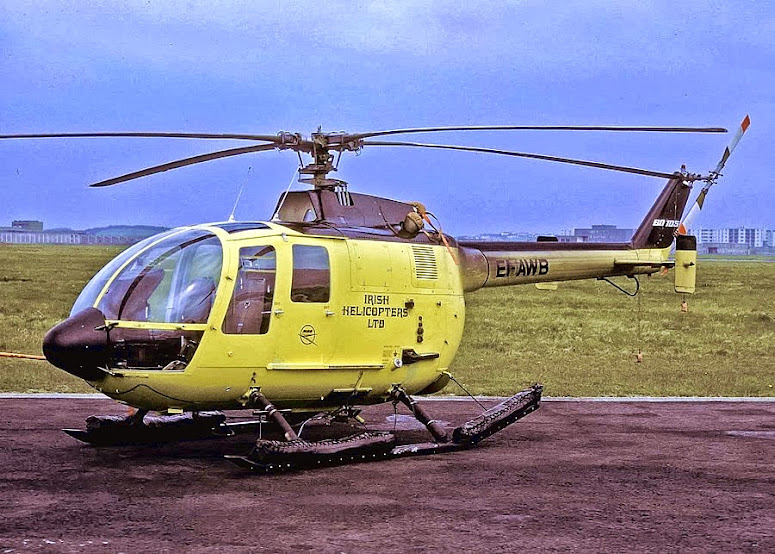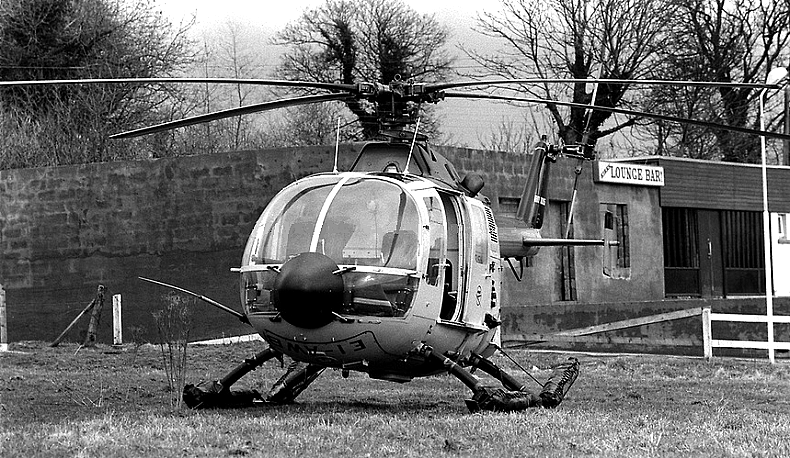 Irish Helicopters Messerschmitt-Bölkow-Blohm Bo105D EI-AWB at Shannon Airport on 23rd April 1973 (Photo: MBB Archives)
Irish Helicopters Messerschmitt-Bölkow-Blohm Bo105D EI-AWB at Shannon Airport on 23rd April 1973 (Photo: MBB Archives)
AWB had an 'exciting' time on the Emerald Isle including, at one point, a brush with the Garda when she was hijacked by the IRA!
 EI-AWB 'rests' in a field in Cloughfin, Co. Donegal on 24th January 1974 having been hijacked by IRA members Eddie Gallagher and Rose Dugdale. (Photo: Victor Patterson)
EI-AWB 'rests' in a field in Cloughfin, Co. Donegal on 24th January 1974 having been hijacked by IRA members Eddie Gallagher and Rose Dugdale. (Photo: Victor Patterson)
Gallagher and Dugdale used the hijacked aircraft to drop bombs (contained in milk churns) on the Royal Ulster Constabulary station at Strabane. Mercifully, none of the bombs detonated.
 EI-AWB 'abandoned' at Cloughfin on 24th January 1974. (Photo: Victor Patterson)
EI-AWB 'abandoned' at Cloughfin on 24th January 1974. (Photo: Victor Patterson)
Of course EI-AWB is better known as
G-AZOM (aka 'Or-gazom' .. to some) which began life as a 'C' model (serial no. 21) originally used as a demonstrator by MBB in 1971 while flying as D-HDAD.
In 1972 she was bought by BEAS at Oxford and later the same year commenced her sojourn in the Irish Republic returning to BEAS (now owned by Bristows) in 1978.
Her 'exciting' career was to continue when in 1984 she suffered a partial separation of her tail rotor gearbox in-flight and which led to fleet-wide modifications to the 105.
Although we've talked about G-AZOM before I don't think we've ever looked at the accident report, an extract of which is reproduced here:
Incident date: 24 July 1984
Commander: Age 40
Experience: 9500 hrs of which 4100 hrs were on Bo105s
The purpose of the 30 minute flight was to transport two passengers from Strubby Heliport in Lincolnshire, to Bacton Gas Terminal in Norfolk. The weather was good and the commander decided to conduct the flight at 1000 feet amsl flying visually on a direct track from Stubby to Bacton. At approximately 11:55 hrs, with one of the passengers in the front left seat, the aircraft lifted from Strubby Heliport for Bacton. The departure was normal and the commander levelled the aircraft at 1000 feet amsl and established a cruising speed of 110 knots.
When the aircraft was approximately 5nm off the coast of Skegness, the commander heard a 'dull bang' from the rear of the aircraft accompanied by a 'twitch' in the pedals. His immediate impression was that something was wrong with the tail rotor and he decided to descend so as to be closer to the surface and also to turn right towards Skegness. At this point there was no apparent loss of yaw control so the commander established the aircraft in a 70 kt powered descent turning to the right. During the descent he felt further vibrations and so decided to ditch. Accordingly, he activated the aircraft's emergency flotation system and called Strubby to announce his ditching but did not transmit a full distress message. The commander instructed his passengers to don their lifejackets. By this time it was apparent that the yaw pedals, though still effective, were losing sensitivity. Nevertheless, the commander flared successfully but, as power was applied in order to reduce the descent rate, all yaw control was lost and the aircraft performed two or three 360° turns to the right before contacting the water.
As a result of the aircraft's rotation when contacting the sea, one of the four floats detached, and the aircraft rolled onto its right side. It stabilised for sufficient time to allow the front seat passenger to jettison his door through which all three occupants escaped. Shortly after the passengers and commander had exited the aircraft, it rolled upside down.
The aircraft was lying on its right side with the detached flotation bag beneath the commander's door preventing it from being opened. However, the front seat passenger had familiarised himself with the jettison mechanism of his door and, as a result of his swift action, this became the most convenient egress. The evacuation of the cabin was completed in less than 30 seconds.
On entering the water one of the passengers inflated his type RFD 102 lifejacket and the commander, who had already inflated his Beaufort Mk15 lifejacket, assisted the remaining passenger with the inflation of his lifejacket. Both passengers were wearing immersion suits but did not have them fully zipped up. However, the water temperature was such that none of the survivors suffered from hypothermia in the half hour between the ditching and the rescue. During this period the commander activated his personal radio locator beacon type BE375 Sabre, and at approximately 12:05 hrs fired the first of his own two red flares. He elected to keep the second to guide the rescuers once he was certain that it would be visible to them and fired it at 12:36 hrs
AAIB Bulletin: G-AZOM